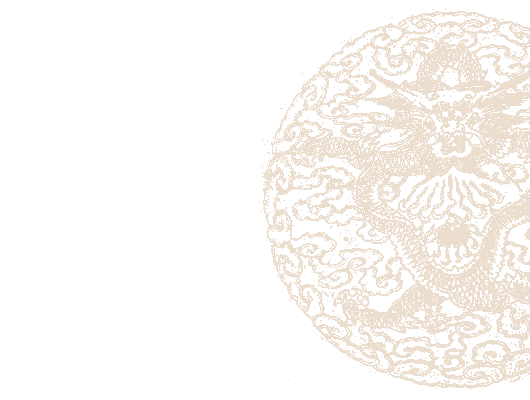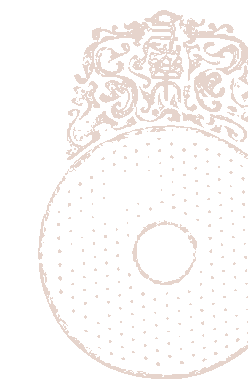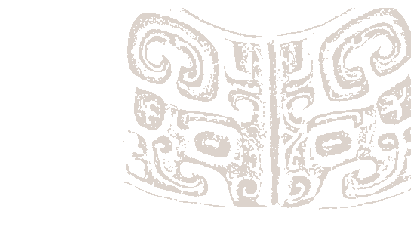From their long experience in making stone
implements, people in ancient times developed an appreciation for
the exceptional durability and luminous beauty of jade. They
believed that this mineral was a sacred material that embodied an
"essential" vital force. Jade was carved into ritual objects based
on the cosmological views and religious faith of the time. The
shapes, designs, and markings of these objects were believed to
channel supernatural powers that could assist in the communication
between the mortal and celestial worlds. From the middle Neolithic
age to the Han dynasty, a period spanning more than 6,000 years
(ca. 6000 B.C. to A.D. 220), the art of jade carving in China
developed with the evolving political, economic, and social
climate to form a "jade venerating tradition" that attributed a
vital force and the power to channel spirits of the other world to
this precious mineral. This vast epoch may be called the "classic
period" of Chinese jade.
From
the Six Dynasties (220-589) onward, social change and the rise of
Buddhism brought upon the gradual decline of jade veneration. The
art of jade carving was revived from the Sung dynasty (960-1279),
but by then it had lost most of its former significance. Nearly
all of the jades exhibited here are exceptional pieces from the
classic period. The traits of each period within this extensive
epoch are described separately in the individual
introductions.
The
original meaning of the word "ritual" was "to serve the gods with
jade" The earliest character for shaman (wu )
tools used to draw circles superimposed at right angles"
)
tools used to draw circles superimposed at right angles" ".
From this we may deduce that shamans perhaps monopolized the
technology for making circular pi
".
From this we may deduce that shamans perhaps monopolized the
technology for making circular pi  discs, and thus had
the exclusive power to present sacrifices to the gods and
ancestral spirits. The round shape of the pi is said to
derive from the circular path that the sun follows in the sky. The
central hole of the disc represents the eternally fixed Pole Star
and the principle of the "absolute" (t'ai-chi
discs, and thus had
the exclusive power to present sacrifices to the gods and
ancestral spirits. The round shape of the pi is said to
derive from the circular path that the sun follows in the sky. The
central hole of the disc represents the eternally fixed Pole Star
and the principle of the "absolute" (t'ai-chi  ) or
"absolute Oneness" (t'ai-i
) or
"absolute Oneness" (t'ai-i  ) in Chinese
philosophy. In the beginning, jade pi discs and ts'ung
) in Chinese
philosophy. In the beginning, jade pi discs and ts'ung
 ritual tubes were used together for sacrificial rites and at
court ceremonies. Later, the kuei
ritual tubes were used together for sacrificial rites and at
court ceremonies. Later, the kuei  tablet replaced the
ts'ung in this pairing. The pi was also the highest
emblem of noble status as well as the most important funerary
object for guiding the spirit of the deceased to heaven. Its role
was so fundamental that one could say the pi permeated the
entire spirit of all jade ritual systems during the classic
period.
tablet replaced the
ts'ung in this pairing. The pi was also the highest
emblem of noble status as well as the most important funerary
object for guiding the spirit of the deceased to heaven. Its role
was so fundamental that one could say the pi permeated the
entire spirit of all jade ritual systems during the classic
period.
The
circular shape of the pi disc perhaps conveyed the
equilibrium, symmetry, completion, and perfect beauty that the
ancients saw in the path of the sun across the sky. It was also
the most important ritual object for assisting in the
communication with the gods and ancestors. Because of its profound
cultural significance, the pi influenced the development of
many classical jades. Its circular motif recurs in the arch,
conical, and cylindrical forms of many other jade objects, as well
as in the round spiral designs with which they are often adorned.
These designs symbolize the eternal cycle of the primeval force of
the universe. From accounts of a struggle between the states of
Ch'in and Chao over a "he-shih pi  disc" in 283 B.C.,
we know that an unblemished pi disc was not only worth the
price of several cities, but that a king would fast for many days
and receive the disc at a ceremony of the highest grandeur.
disc" in 283 B.C.,
we know that an unblemished pi disc was not only worth the
price of several cities, but that a king would fast for many days
and receive the disc at a ceremony of the highest grandeur.
This
exhibit includes several pi discs of great beauty and
significance. All were probably used in important ancient rituals
to assist in communication with the gods. Withstanding the test of
time, they retain all of their former mystique and vitality. One
of the jade pi discs from the Liang-chu Culture (ca.
3200-2000 B.C.) is etched with the marking of a bird perched on an
altar. This suggests to us that the "Sun Bird" was the totem of
Neolithic tribes inhabiting the lower Yangtze River valley. Up
until the Han dynasty, pi discs were not only frequently
hung at the imperial palace, but "treasured jade pi discs"
were also objects of veneration. The pi disc in this
exhibit carved with the characters for "perpetual happiness
(ch'ang-lo  )" also includes a
dragon and tiger design on the inner rim and a dragon, tiger,
phoenix, and turtle-and-snake pair (the "four spirit animals")
arranged clockwise along the outer rim. These are both perhaps
expressions of the ancient belief that the universe revolved
around the earth.
)" also includes a
dragon and tiger design on the inner rim and a dragon, tiger,
phoenix, and turtle-and-snake pair (the "four spirit animals")
arranged clockwise along the outer rim. These are both perhaps
expressions of the ancient belief that the universe revolved
around the earth.
Both
in their shape and profound decorations on their surface,
pi discs convey a yearning for immortality. The ancients
who used them sought to worship the greatness of nature with
objects made of a material that best embodied this quality. In
high antiquity, it was believed that similar things generated an
empathy between each other. Ultimately they sought to attain a
state of oneness and harmony between man and nature.
The
appreciation of archaic Chinese jades involves more than just the
enjoyment of their solemn aloofness and brilliant luster. One must
look beyond their physical properties--what can be seen and
touched--to the metaphysical spirit that they embody. This spirit
is born of the Chinese veneration of heaven and ancestors. It
grows moreover from a culture that seeks to live in harmony with
nature. In presenting this selection of refined jades, appealing
to many different tastes, this special exhibition hopes to share
with viewers this age-old Chinese tradition of placing equal
importance on the metaphysical as well as the
physical.





